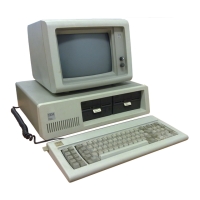Data
Set Ready
(DSR),
Pin
37: When low, indicates that the
MODEM
or data set
is
ready to establish the communications link and
transfer data with the INS8250. The
DSR
signal
is
a MODEM-control
function input whose condition can be tested by the
CPU
by reading Bit
5 (DSR)
of
the
MODEM
Status Register. Bit 1 (DDSR) of the
MODEM
Status Register indicates whether the
DSR
input has
r""\
changed state since the previous reading of the
MODEM
Status
Register.
~
Whenever the
DSR
bit
of
the
MODEM
Status Register changes
state, an interrupt
is
generated if the
MODEM
Status Interrupt
is
enabled.
Received Line Signal Detect
(RLSD),
Pin 38: When low, indicates
that the data carrier has been detected by the
MODEM
or data set.
The RLSD signal
is
a MODEM-Control function input whose
condition can be tested by the
CPU
by reading Bit 7 (RLSD) of the
MODEM
Status Register. Bit 3 (DRLSD) of the
MODEM
Status
Register indicates whether the RLSD input has changed state since the
previous readingof the
MODEM
Status Register.
Note: Whenever the RLSD bit of the
MODEM
Status Register
changes state, an interrupt
is
generated
if
the
MODEM
Status Interrupt
is
enabled.
~
Ring Indicator
(RI),
Pin
39: When low, indicates that a telephone
ringing signal has been received by the
MODEM
or data set. The RI
signal
is
a MODEM-control function input whose condition can be
tested by the
CPU
by reading Bit 6 (RI)
of
the
MODEM
Status
Register. Bit 2 (TERI) of the
MODEM
Status Register indicates
whether the RI input has changed from a low to a high state since the
previous reading
of
the
MODEM
Status Register.
Note: Whenever the RI bit
of
the
MODEM
Status Register changes
from a high to a low state, an interrupt
is
generated if the
MODEM
Status Interrupt
is
enabled.
vce,
Pin
40:
+5
volt supply.
VSS,
Pin
20: Ground (O-volt) reference.
2-131

